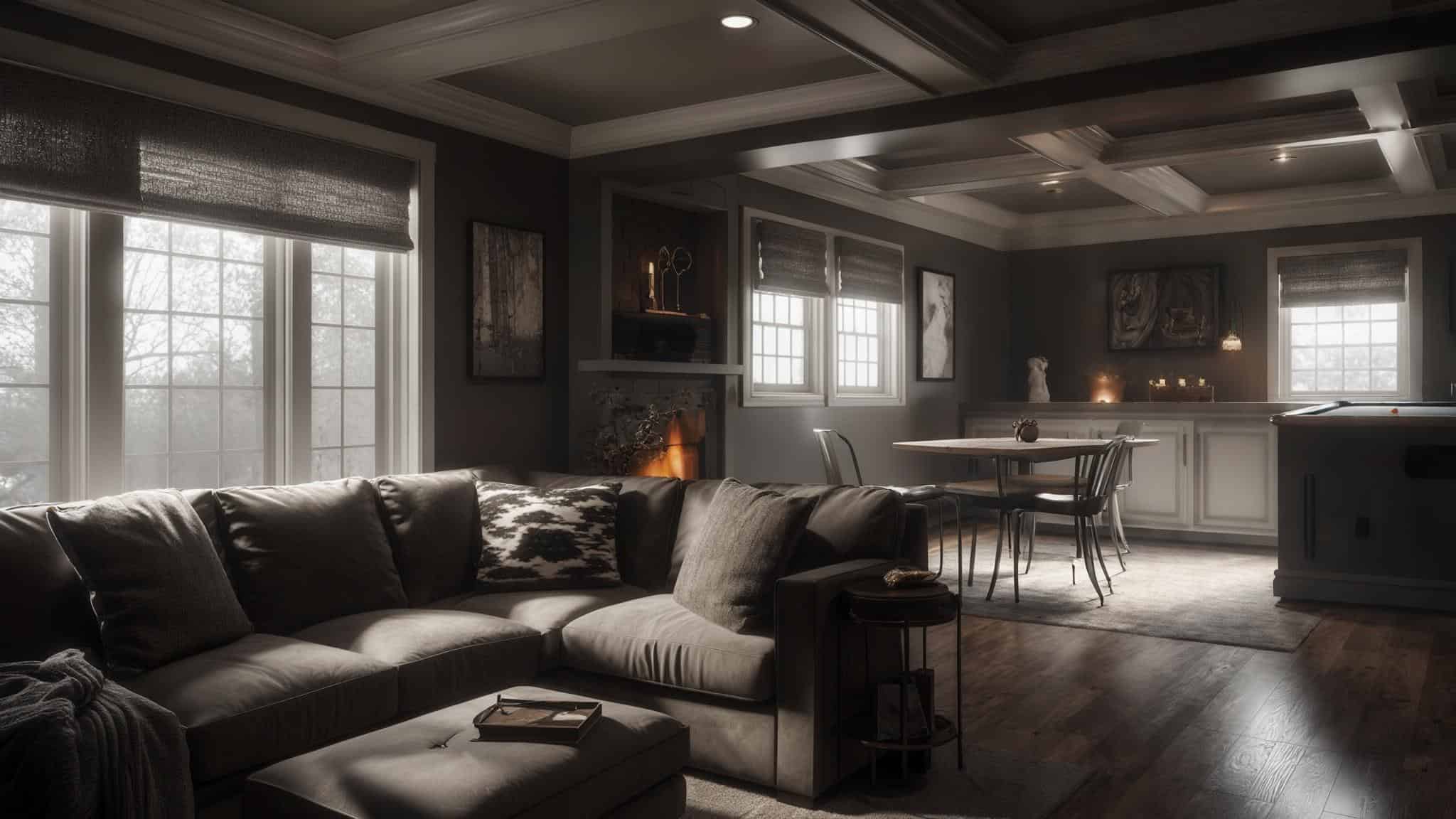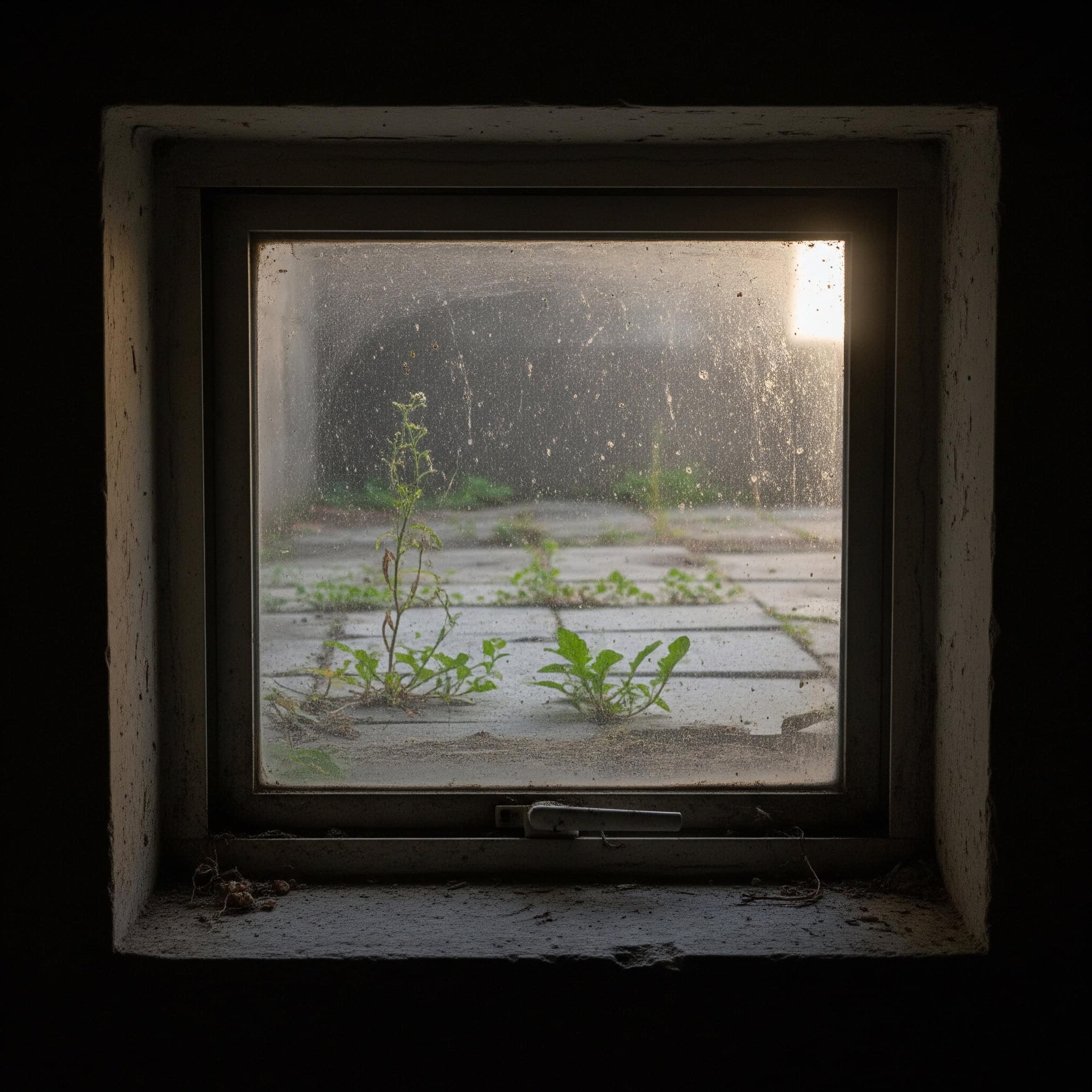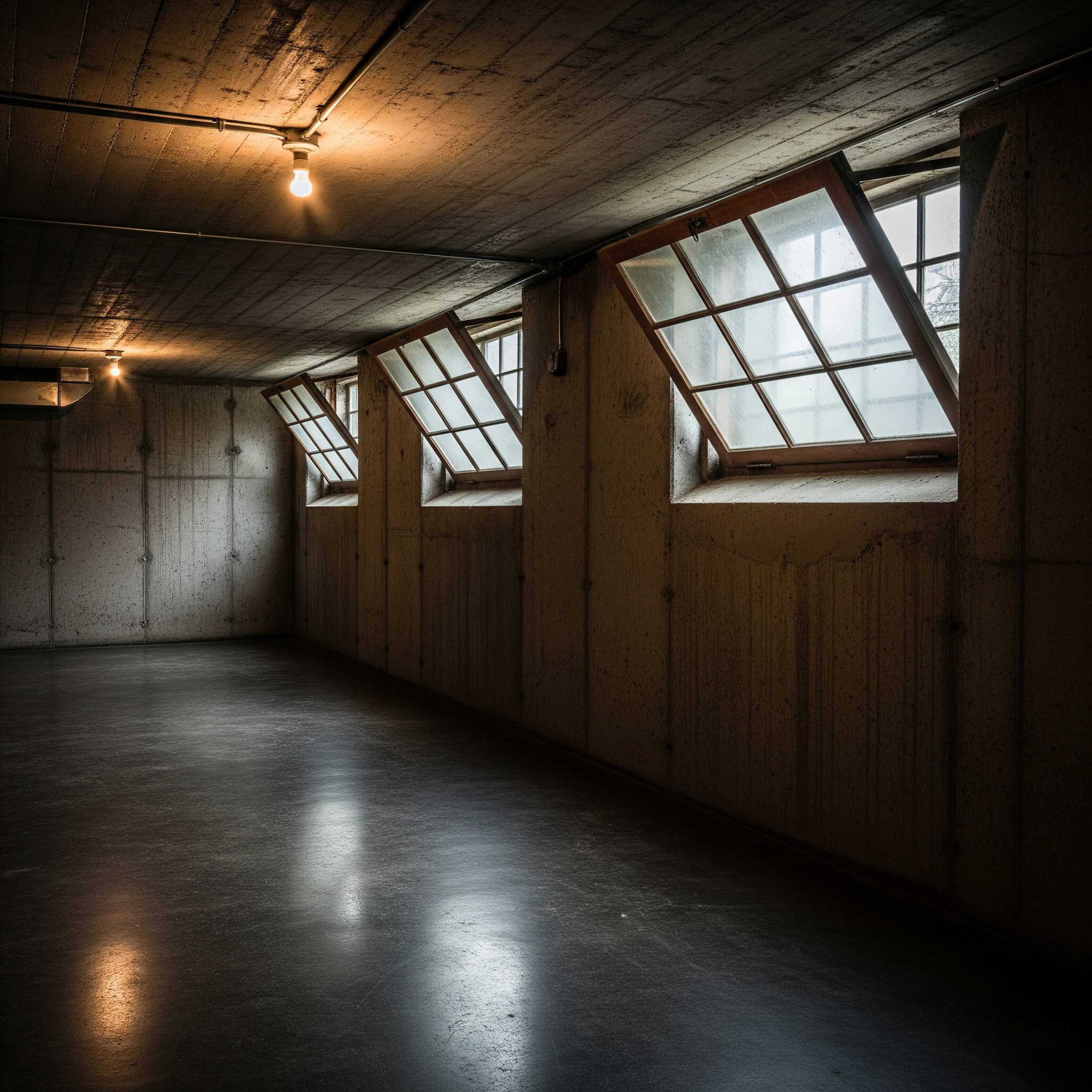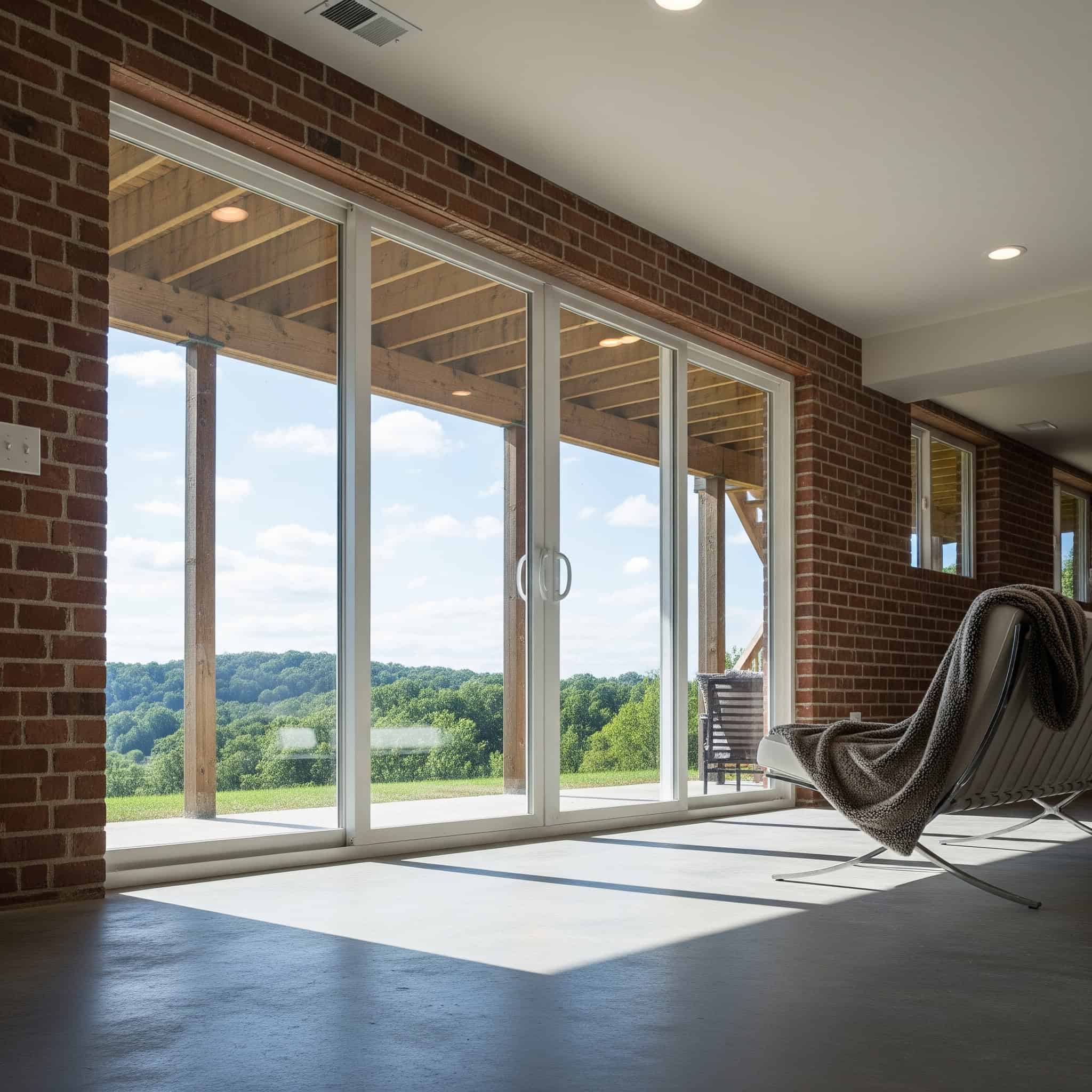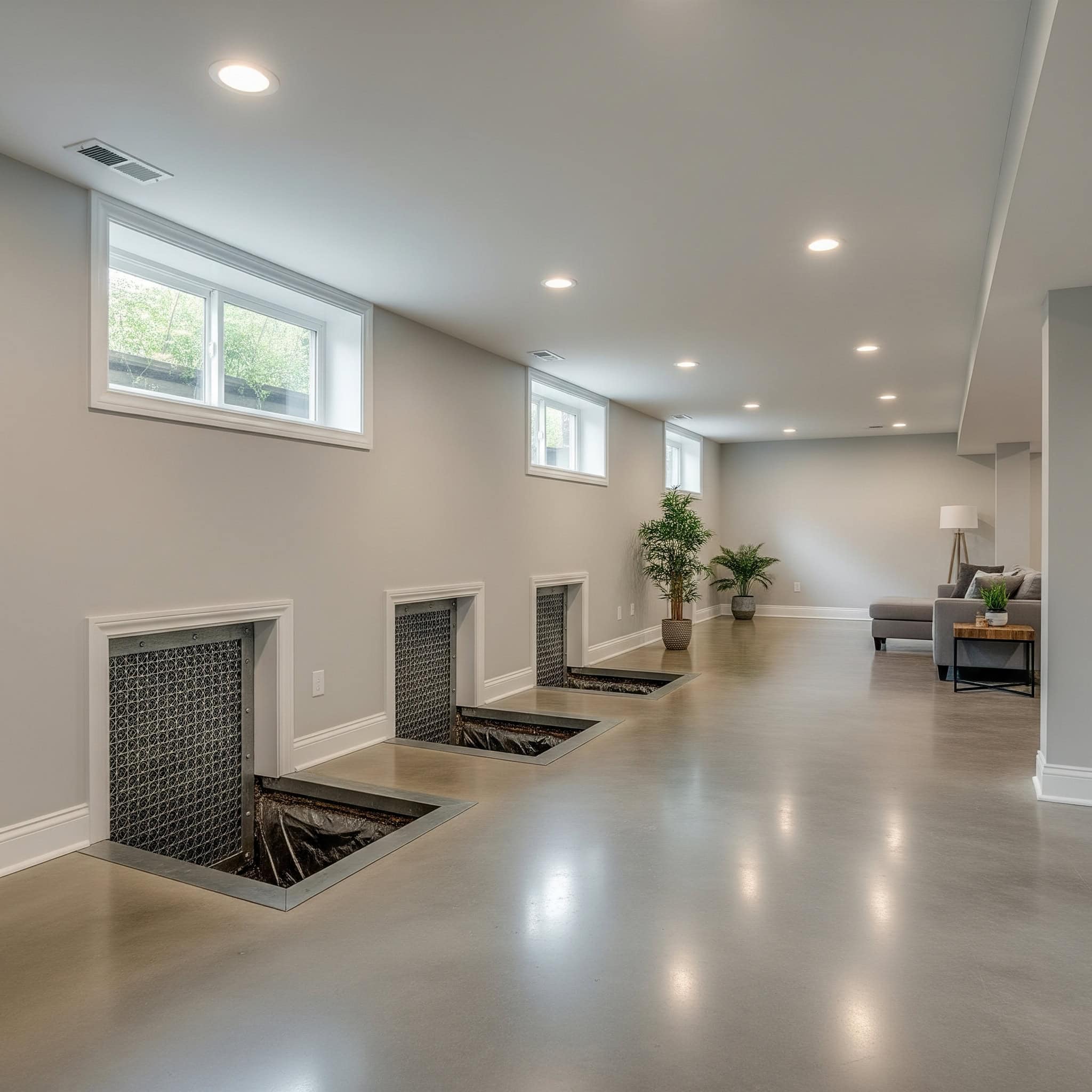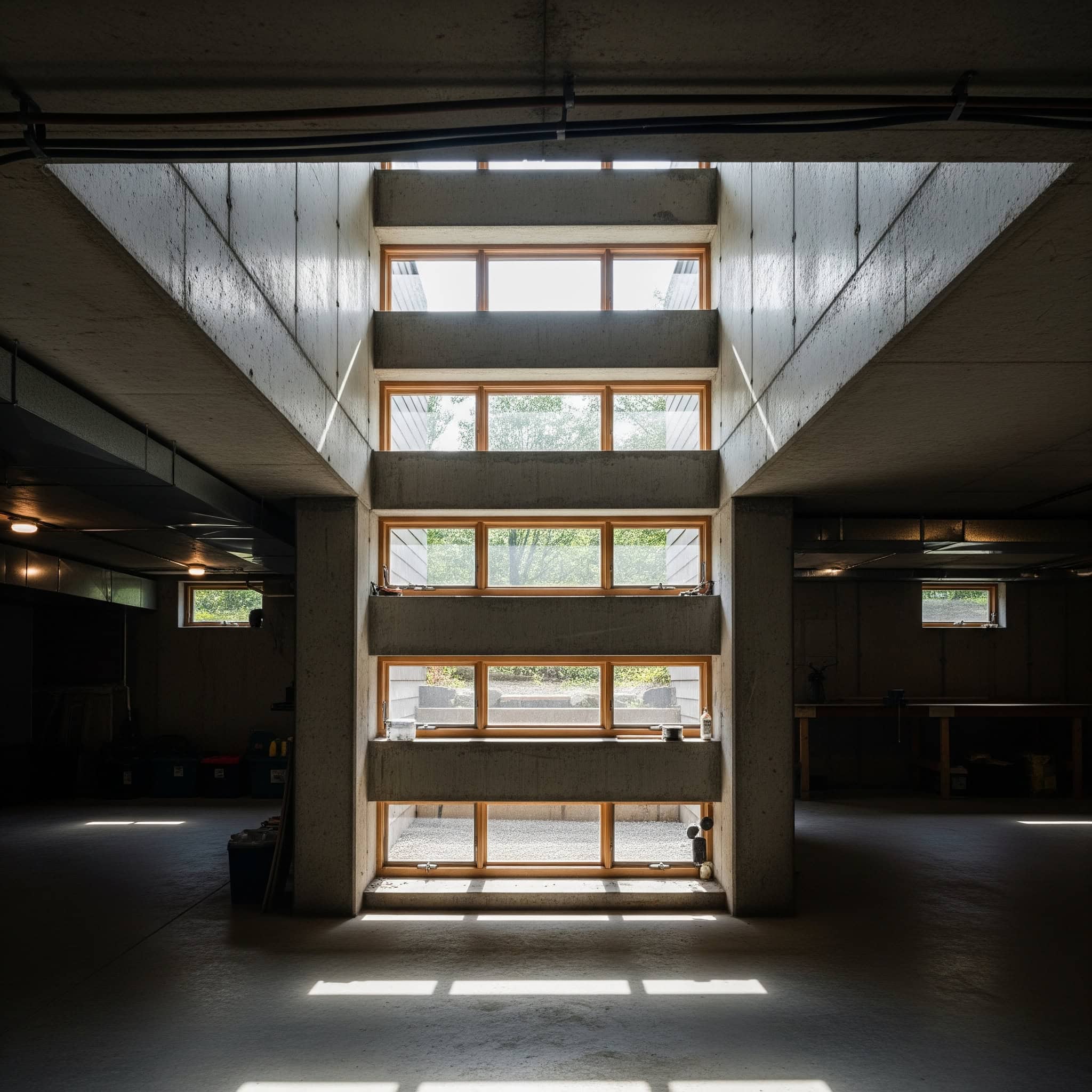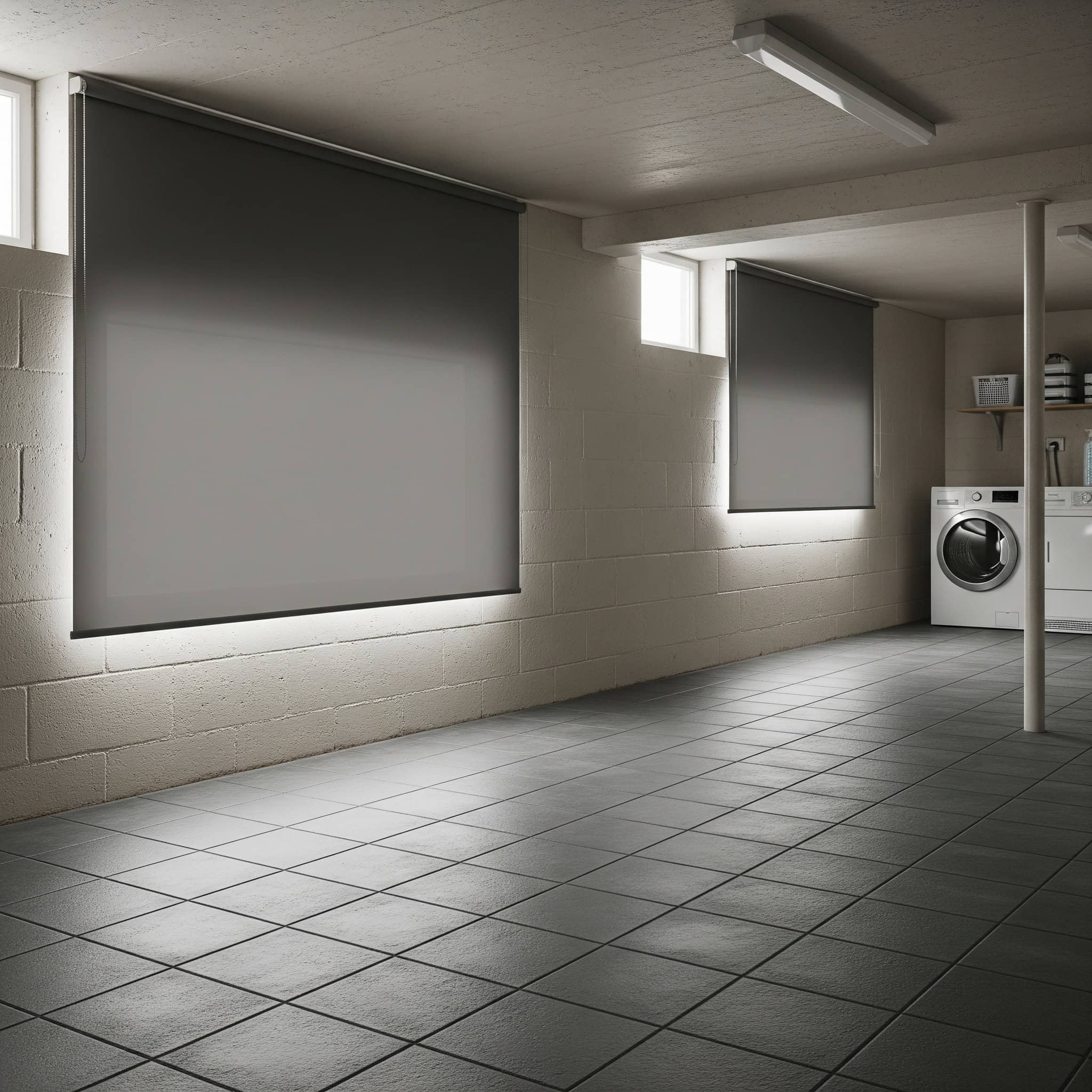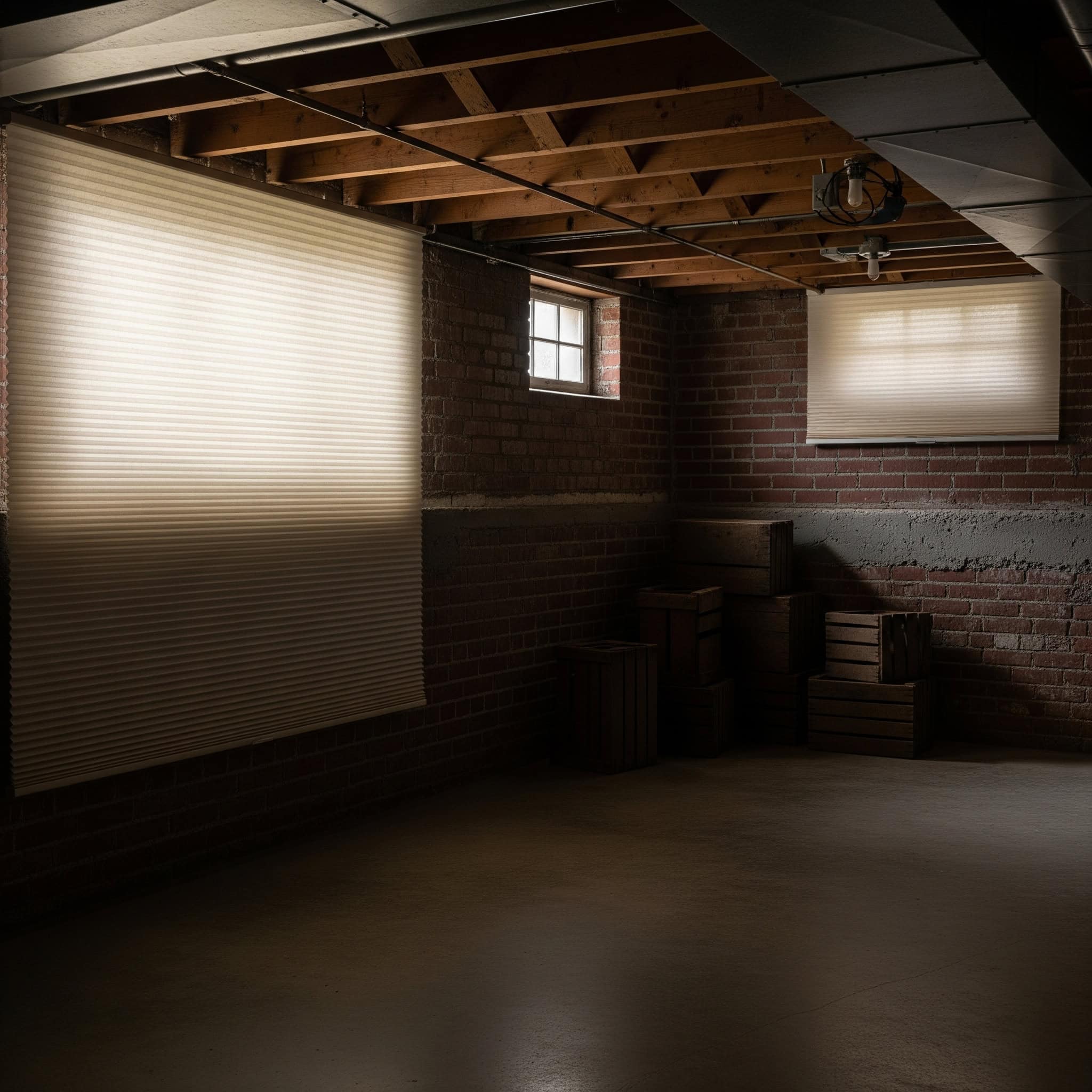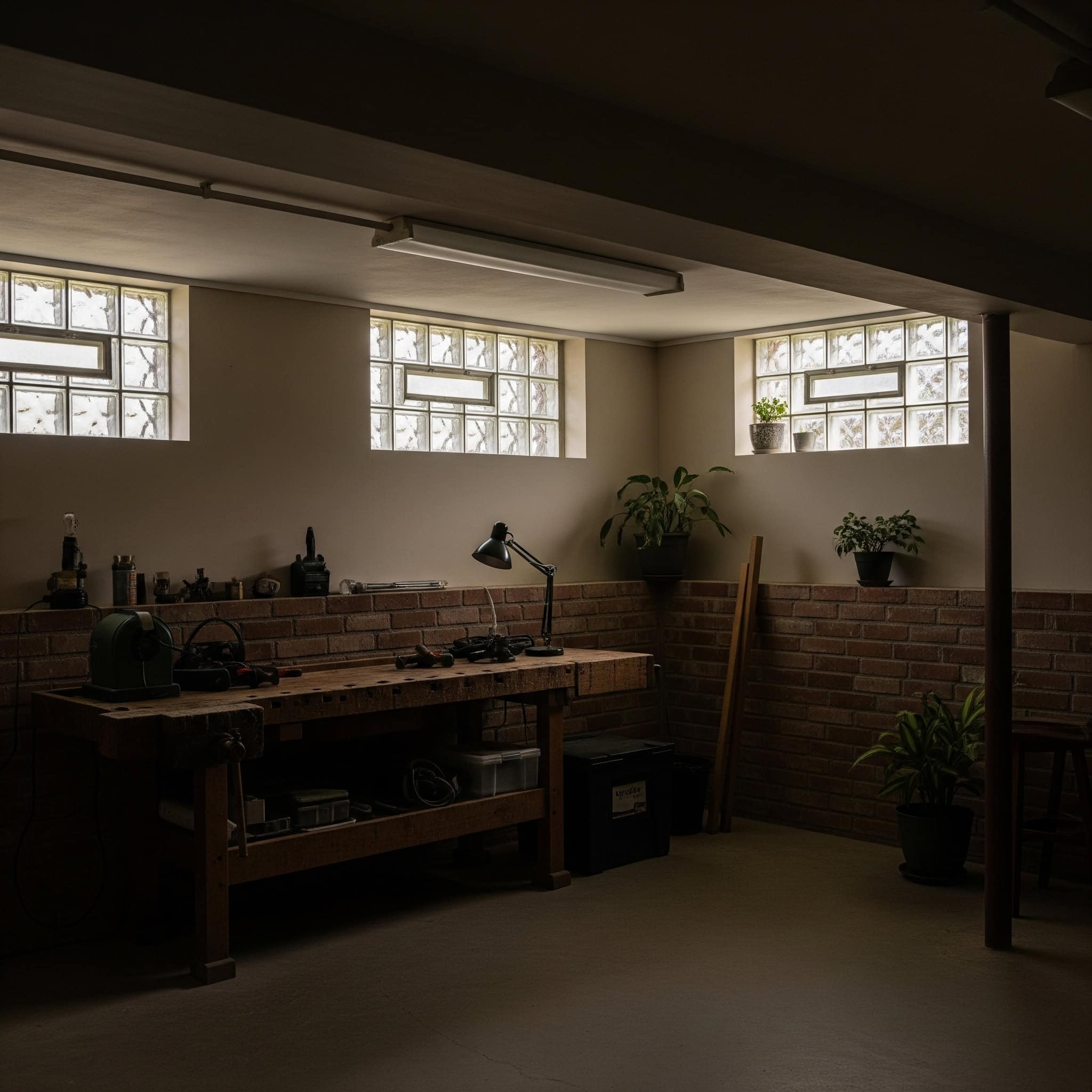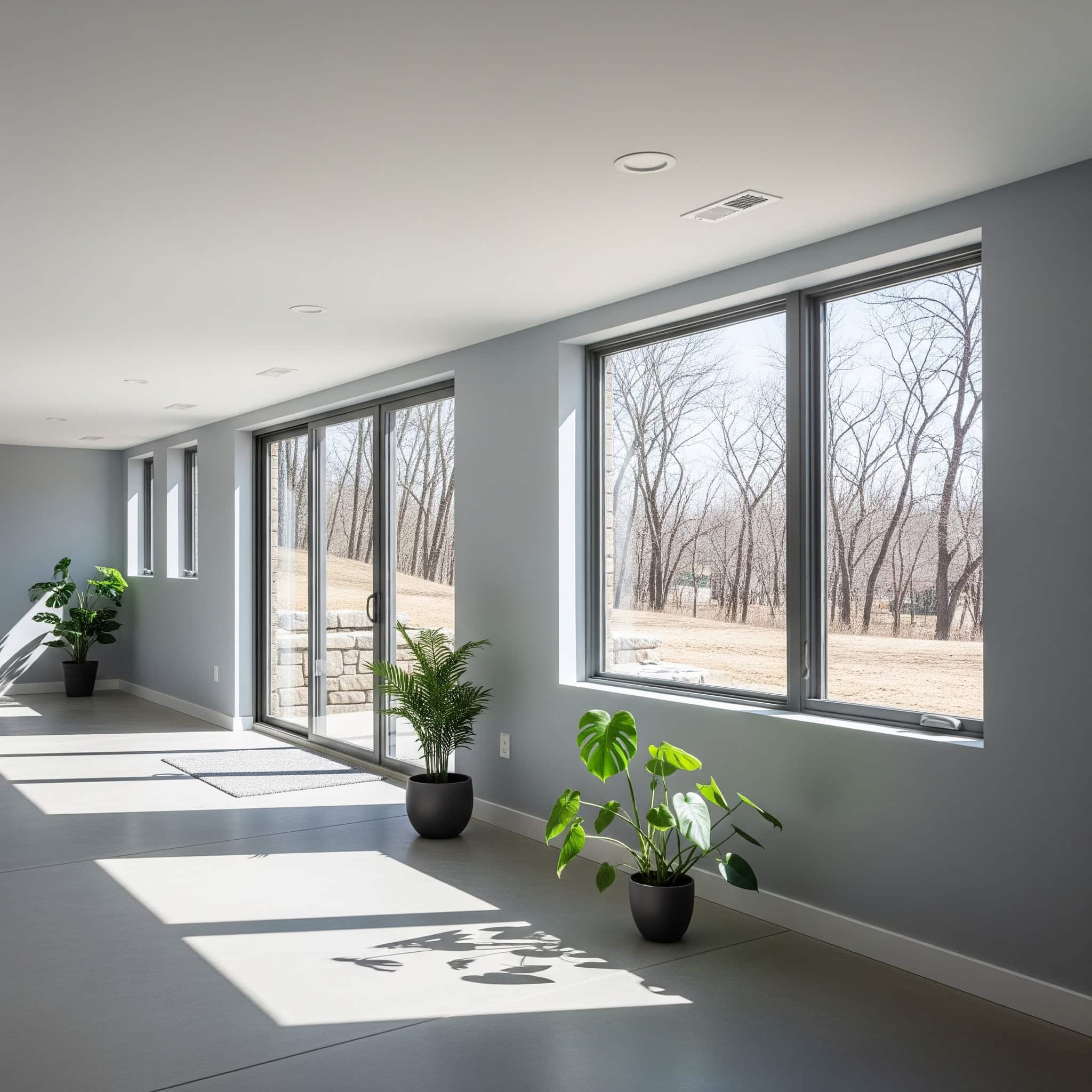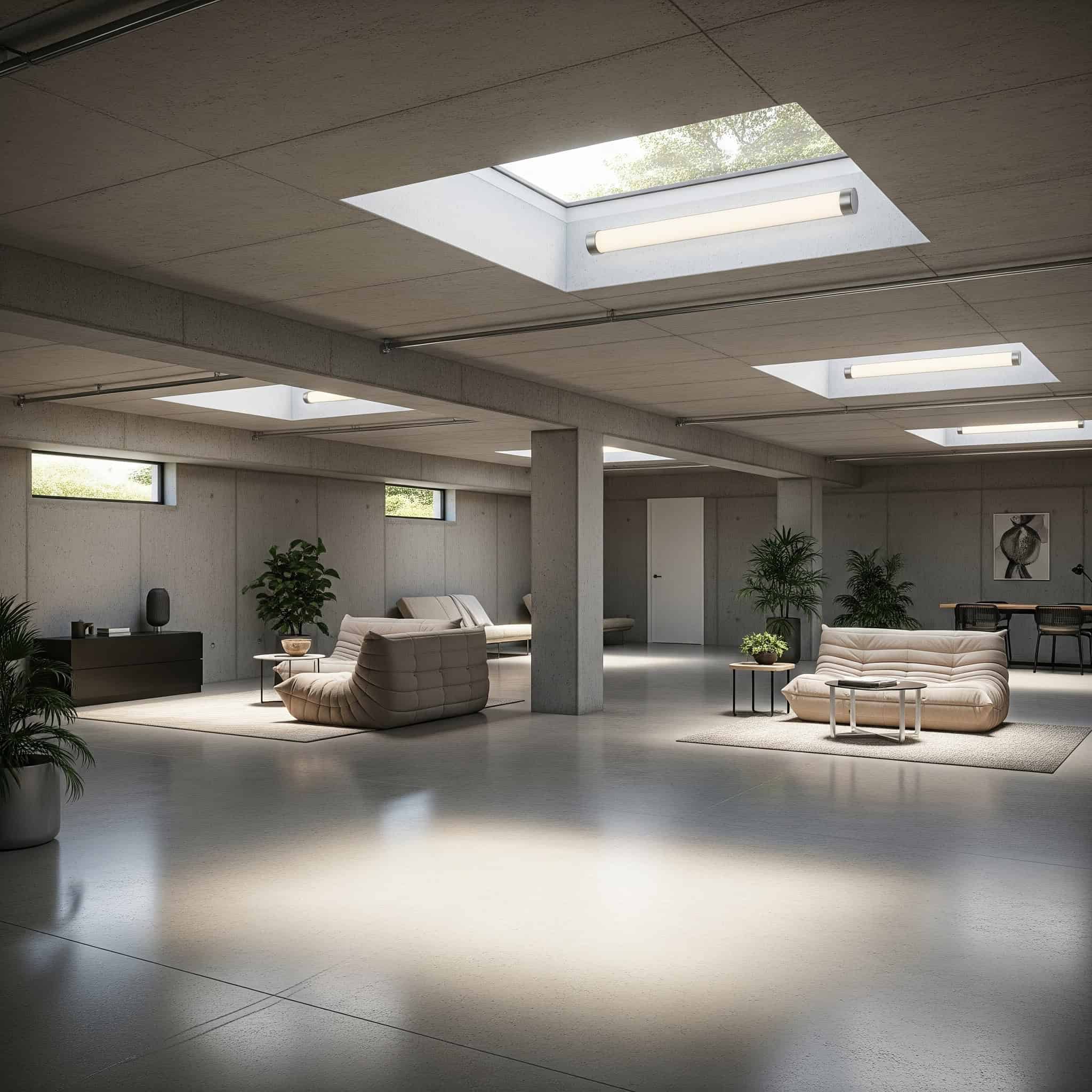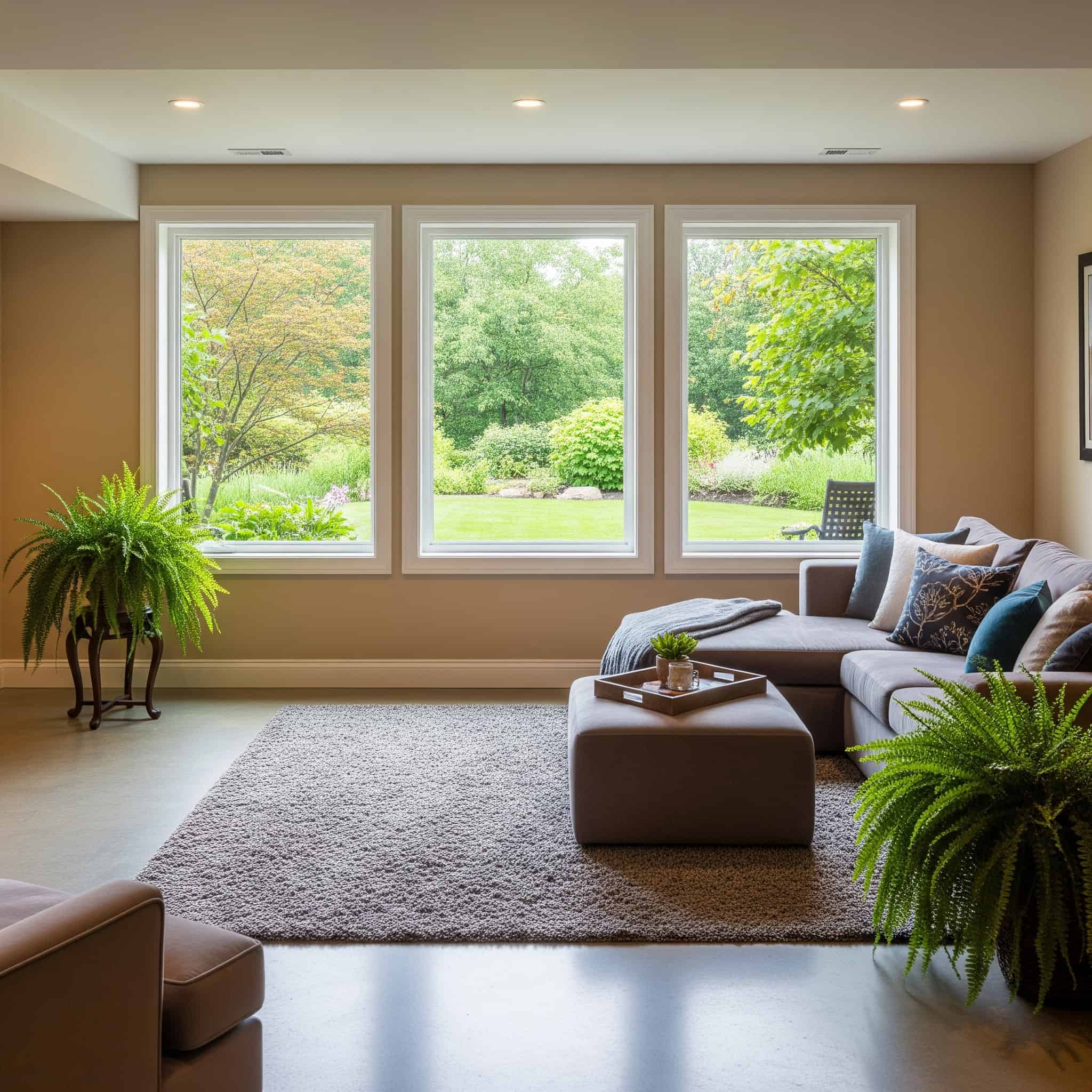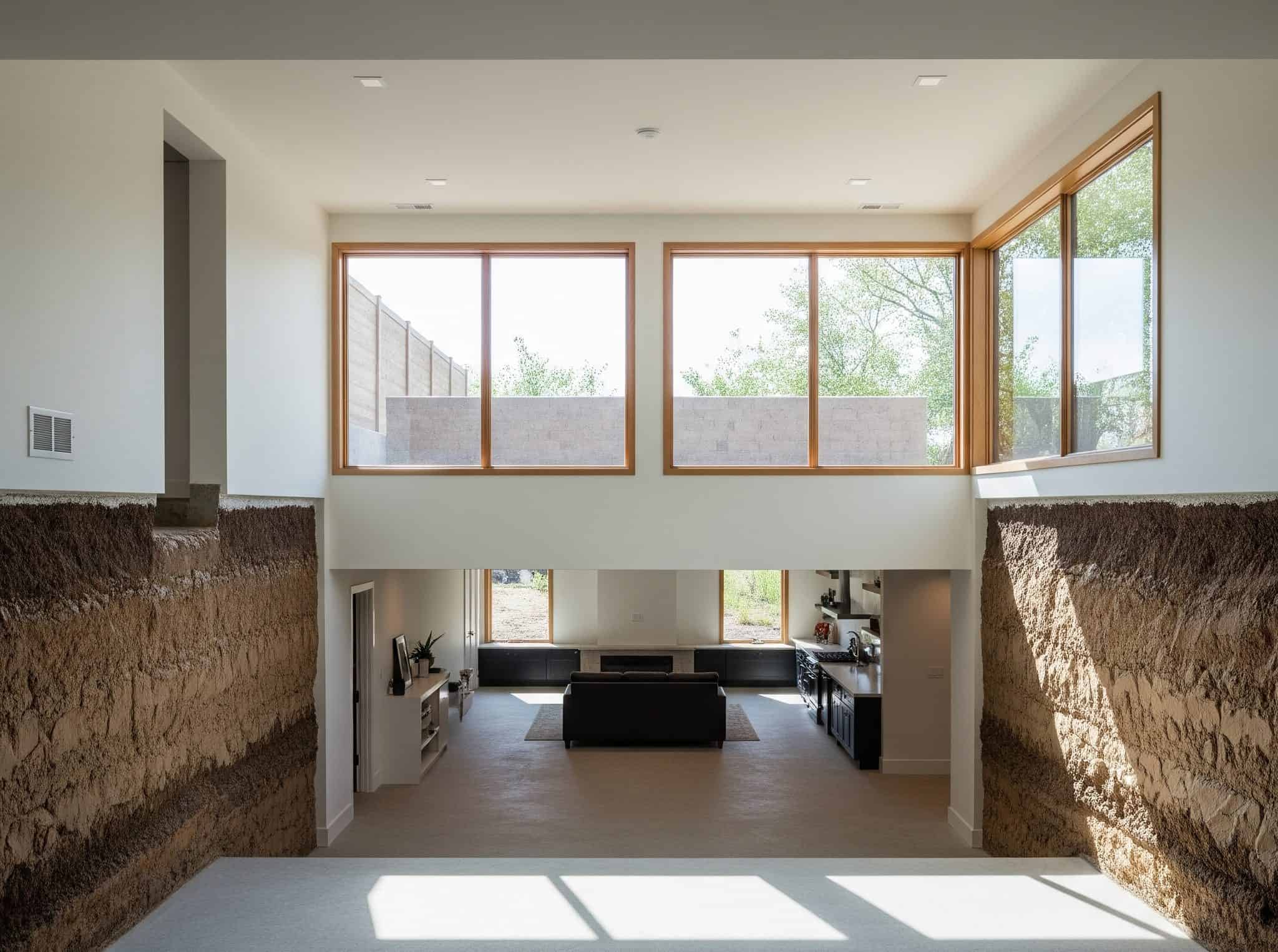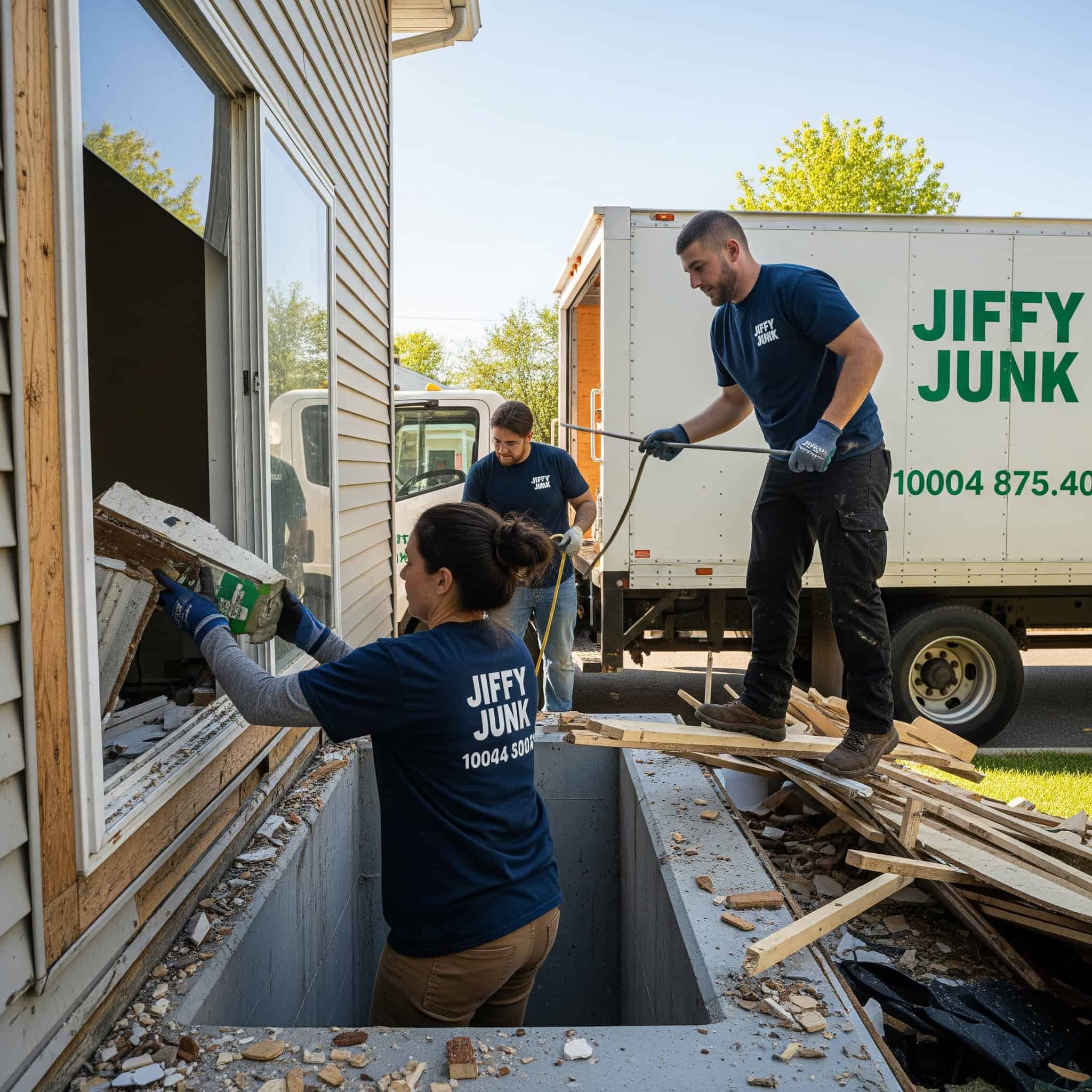25 Innovative Basement Window Ideas That Will Transform Your Space in 2025
According to a recent National Association of Home Builders survey, 85% of homeowners consider natural light a critical factor when renovating basement spaces. I’ve worked with countless adults transforming their dark, uninviting basements into bright, functional living areas. The right window choices make all the difference in these below-grade spaces. This comprehensive guide explores 25 basement window ideas across five categories to help you make informed decisions for your renovation project.
Basement windows serve multiple critical functions beyond just looking good. They allow natural light to enter your space, provide necessary ventilation, serve as emergency exits, and help maintain energy efficiency throughout your home.
The market for basement windows is growing rapidly, with projections showing a 4.7% annual increase through 2025. This growth is primarily driven by homeowners undertaking more basement renovations and the implementation of stricter building codes requiring proper egress solutions.
What to Consider When Choosing Basement Windows
Selecting the right basement windows requires careful evaluation of several key factors. Your decision should balance functional requirements like light entry and ventilation with safety considerations such as egress compliance. Additionally, you’ll need to account for energy efficiency, water resistance, security features, aesthetic appeal, maintenance needs, and budget constraints.
Local building codes typically require basement bedroom windows to have a minimum opening of 5.7 square feet, with minimum height and width dimensions of 24 inches and 20 inches respectively. These requirements aren’t arbitrary—they ensure anyone can safely exit through the window in an emergency.
Basement windows experience up to 40% more water exposure than above-grade windows, making proper installation and waterproofing absolutely critical. Without proper sealing and drainage, you’re inviting moisture problems that can lead to mold, rot, and structural damage.
|
Consideration Factor |
Why It Matters |
Impact on Decision |
|---|---|---|
|
Light Entry |
Affects usability and mood of space |
Determines window size and placement |
|
Ventilation |
Controls humidity and air quality |
Influences opening mechanism selection |
|
Egress Compliance |
Required by building codes for bedrooms |
Dictates minimum size and accessibility |
|
Water Resistance |
Prevents moisture damage and mold |
Affects installation method and materials |
|
Energy Efficiency |
Impacts heating/cooling costs |
Determines glass type and frame materials |
|
Security |
Protects against intrusion |
Influences hardware and glass specifications |
Window Types and Materials
When planning your basement renovation, it’s important to consider how the windows will impact the overall project. Our guide on reclaiming basement space through junk removal can help you prepare your area before installation begins.
1. Hopper Windows
Hopper windows tilt inward from the top, making them ideal for basement installations where space is limited. They provide excellent ventilation while maintaining security when closed. The inward-opening design prevents interference with window wells and creates tight seals for energy efficiency.
These windows typically achieve 15-20% better energy efficiency ratings than sliding windows due to their compression seal design. This makes them particularly valuable in basements where temperature regulation can be challenging.
While standard sizes typically don’t meet egress requirements, they’re cost-effective options for non-bedroom spaces where natural light and air circulation are priorities. The average installation cost ranges from $250-$700 per window, making them one of the more affordable basement window ideas.
2. Awning Windows
Awning windows open outward from the bottom, providing ventilation even during light rain—a valuable feature for moisture-prone basements. They offer good security when closed and can remain partially open without compromising safety.
You can leave these windows open during light rain, reducing basement humidity levels by up to 15% compared to closed windows. This feature alone makes them worth considering for damp basement environments.
Standard sizes rarely meet egress requirements, so they work best in non-bedroom basement areas unless specifically designed as egress windows. Their outward opening requires adequate window well space but provides excellent protection from the elements. Modern awning windows feature multi-point locking systems that increase security by up to 30% compared to single-lock window designs.
3. Sliding Windows
Sliding windows operate horizontally along tracks, making them practical for basements with limited window well depth. Their operation doesn’t require clearance space, and larger models can meet egress requirements while maintaining a streamlined profile.
These windows typically feature a glass-to-frame ratio of 80%, maximizing natural light entry compared to other window styles. This high ratio makes them excellent choices for dark basement spaces that need as much light as possible.
They typically offer moderate energy efficiency and require occasional track cleaning to maintain smooth operation, especially in basement environments where dirt and moisture accumulate. The track system requires cleaning approximately twice yearly to prevent operational issues, with silicone-based lubricants recommended for smooth operation.
4. Casement Windows
Casement windows open outward like a door, offering excellent ventilation by capturing and directing air into the basement. When properly sized, they’re one of the best options for meeting egress requirements while maximizing the glass-to-frame ratio for better light entry.
These windows can provide up to 90% ventilation of the total window opening, compared to 50% for double-hung windows. This makes them particularly effective for improving air circulation in basement spaces.
The compression seal created when closed provides superior energy efficiency and weather resistance, though they require sufficient window well space for the outward swing. The cranking mechanism typically maintains functionality for 15-20 years before requiring replacement, with stainless steel components offering the best longevity in basement environments.
A client in Minneapolis transformed their dark basement into a bright home office by replacing two small hopper windows with large casement windows. By installing 36″ x 60″ casement windows with enlarged window wells, they increased natural light by 70% and met egress requirements. The compression seal design reduced drafts, lowering their winter heating costs by approximately $120 annually compared to their previous windows. The cranking mechanism made operation easy even when positioned behind a desk, and the full opening provided excellent cross-ventilation during summer months.
5. Fiberglass Frame Windows
Fiberglass frames deliver exceptional performance in challenging basement environments. They resist warping, rotting, and structural degradation from moisture exposure and temperature fluctuations. They provide superior insulation compared to aluminum frames and can be finished to resemble painted wood for aesthetic appeal.
Fiberglass frames have an R-value approximately 15% higher than vinyl and 400% higher than aluminum, significantly reducing heat transfer. This improved insulation performance makes them particularly valuable in basements where temperature regulation is often challenging.
While the initial investment exceeds vinyl options, their durability and energy efficiency justify the cost over time, especially in basements where replacement is disruptive and costly. The expected lifespan of fiberglass frames exceeds 50 years, compared to 30 years for vinyl and 20-25 years for aluminum in basement applications.
|
Window Frame Material |
Initial Cost |
Lifespan |
Maintenance |
Energy Efficiency |
Best For |
|---|---|---|---|---|---|
|
Vinyl |
$-$ |
20-30 years |
Low |
Good |
Budget-conscious projects |
|
Fiberglass |
$-$$ |
50+ years |
Very Low |
Excellent |
High-humidity environments |
|
Aluminum |
$-$ |
20-25 years |
Moderate |
Poor |
Modern aesthetic, strength |
|
Wood |
$-$$ |
30+ years (with maintenance) |
High |
Very Good |
Historic renovations |
|
Composite |
$-$$ |
30-40 years |
Low |
Very Good |
Balance of aesthetics and durability |
Egress Window Solutions
6. Egress Window Kits
Egress window kits provide comprehensive systems including appropriately sized windows, wells, and covers designed to meet building code requirements for emergency escape. These kits simplify the planning process by ensuring all components work together and comply with regulations.
Complete egress kits typically cost between $2,500-$5,000 installed, compared to $3,000-$7,000 for custom solutions. This price difference makes them attractive options for homeowners working with tight renovation budgets.
Professional installation is recommended since it involves cutting through foundation walls. While kits limit customization options, they provide peace of mind regarding safety compliance and typically include proper drainage solutions. Professional installation typically requires 1-2 days per window, with concrete cutting representing approximately 30% of the total installation time.
7. Enlarged Window Wells
Expanded window wells create spacious openings that enhance both safety and livability. Modern options include built-in steps or ladders for emergency exit, and the increased space allows more light to enter the basement.
Enlarged window wells typically extend 36-48 inches from the foundation wall and require excavation approximately 12 inches deeper than the window bottom. This additional space not only improves safety but also allows for decorative elements that enhance your home’s exterior appearance.
These wells require significant excavation around the foundation and must include proper drainage systems. High-quality wells made of galvanized steel, composite materials, or reinforced polyethylene offer durability and can incorporate decorative elements to enhance your home’s exterior. Proper drainage systems can process up to 25 gallons of water per hour, preventing basement flooding during heavy rainfall.
8. Walkout Egress Windows
Walkout windows function as secondary doors with steps leading up to ground level. This approach maximizes natural light, ventilation, and ease of emergency exit. Installation involves significant foundation work and exterior landscaping but dramatically enhances basement livability and potential resale value.
When installing walkout egress windows, you’ll likely need to handle construction debris removal. Check out our guide on construction waste disposal options to efficiently clear your renovation area.
Walkout installations typically increase property values by 10-15% of their installation cost, making them one of the highest ROI basement improvements. While they’re the most expensive egress option, walkouts effectively transform basement spaces into true living areas with direct outdoor access, particularly valuable for basement apartments or in-law suites. The average installation requires removing 15-20 cubic yards of soil and approximately 15 square feet of foundation wall.
9. Bubble Window Wells
Semi-circular clear acrylic covers extend outward from the foundation, creating more space and light while protecting the window opening from precipitation and debris. They’re less invasive to install than enlarged wells while still improving light entry and potentially helping meet egress requirements.
Polycarbonate bubble covers can withstand up to 400 pounds of distributed weight, providing safety against accidental falls. This strength makes them practical solutions for areas where people might walk near the window wells.
The clear design maintains visibility and natural light while providing protection, though in snowy climates, they require occasional clearing to maintain emergency exit capability. UV-resistant models maintain 90% clarity for approximately 10-15 years before requiring replacement due to yellowing.
A homeowner in Seattle installed bubble window wells for their basement home gym. The previous metal window wells collected leaves and debris, blocking 50% of the available light. After installing 42-inch clear polycarbonate bubble wells, natural light increased dramatically, and the homeowner reported no maintenance issues for three years. During a heavy snowfall, they simply brushed snow from the surface to maintain egress functionality. The clear bubbles also allowed them to see outside while using their treadmill, creating a more pleasant exercise environment. Total cost for three wells with installation was $1,850, significantly less than their previous quote of $4,200 for enlarged masonry wells.
10. Tiered Window Wells
Featuring step-like designs with decorative stone or concrete tiers, these wells combine functionality with aesthetic appeal. The tiered construction naturally creates steps for emergency egress while allowing for decorative plantings or stone arrangements.
Tiered wells typically incorporate 3-4 steps with a rise of 6-8 inches each, meeting most local building codes for egress access. This design not only satisfies safety requirements but also creates an attractive exterior feature.
They require professional installation to ensure structural integrity and proper drainage between tiers. While more expensive than basic wells, they transform utilitarian egress windows into architectural features that add value to your property. Proper installation includes approximately 6-8 inches of drainage gravel beneath each tier to prevent water accumulation.
Window Treatments and Coverings
11. Cellular Shades
Honeycomb-structured fabric shades create insulating air pockets that help regulate basement temperatures while controlling light. Available in light-filtering or room-darkening options, they work well in basement media rooms or bedrooms.
Double-cell designs provide approximately R-3.5 insulation value, reducing heat loss through windows by up to 40%. This insulating property makes them particularly valuable in basements, which often struggle with temperature regulation.
Their compact profile when raised maximizes limited window space. Choose humidity-resistant fabrics for basement environments. Top-down/bottom-up options provide flexibility for balancing privacy with light entry—particularly valuable for partially above-grade basement windows. Antimicrobial treatments on basement-grade cellular shades inhibit mold growth in environments with relative humidity up to 65%.
12. Moisture-Resistant Roller Blinds
Vinyl or polyester roller shades with antimicrobial treatments stand up well to basement humidity while providing simple, streamlined window coverage. They’re easy to clean with a damp cloth—practical for basement environments where dust and moisture accumulate.
PVC-free polyester blinds with antimicrobial treatments can resist mold growth for 5-7 years in typical basement conditions. This durability makes them excellent long-term solutions for basement window treatment ideas.
They offer excellent privacy and light control at an affordable price point. Continuous-loop cord systems or motorized options make operation convenient, especially for hard-to-reach basement windows. Motorized systems add approximately $100-150 per window but eliminate accessibility issues for windows behind furniture or in awkward locations.
13. Interior Shutters
Vinyl or composite plantation-style shutters offer exceptional durability in basement environments while adding architectural interest. Unlike wood shutters, these materials resist warping in variable basement humidity.
Composite shutters provide approximately R-2.8 to R-3.4 insulation value when closed, reducing energy costs by up to 25% compared to uncovered windows. This energy efficiency makes them particularly valuable in basements, which often struggle with temperature regulation.
The adjustable louvers provide precise control over light and privacy, and their insulating properties help maintain comfortable basement temperatures. The hinged panels allow full access to windows for cleaning or emergency egress. Quality vinyl and composite shutters maintain structural integrity in humidity fluctuations between 30-80%, common in basement environments.
14. Window Film
Privacy or decorative adhesive films provide an affordable, easy-to-apply solution for basement windows. Available in various patterns, frosted finishes, or stained glass effects, they enhance privacy without sacrificing light.
High-quality window films block 99% of UV rays while reducing solar heat gain by 30-60%, protecting furniture from fading. This protection is particularly valuable in basement spaces where furniture might be positioned directly in front of windows.
Many options include UV-blocking properties to protect basement furnishings. While offering minimal insulation benefits, they’re ideal for windows that don’t require frequent opening and can be combined with other basement window coverings ideas for enhanced performance. Professional-grade films maintain effectiveness for 10-15 years before requiring replacement, with DIY options typically lasting 5-7 years.
15. Exterior Window Well Covers
Clear polycarbonate domed covers attach to the house exterior, preventing debris, precipitation, and small animals from entering window wells while maintaining light transmission. They enhance security and help prevent water infiltration issues common with basement windows.
Commercial-grade polycarbonate covers can support up to 400 pounds of distributed weight while maintaining emergency egress functionality. This strength ensures safety even if someone accidentally steps on the cover.
Quality covers are designed to be removable for emergency egress and strong enough to support snow loads or accidental foot traffic. Some models include locking mechanisms for additional security. Properly installed covers reduce window well maintenance by approximately 75% and extend the life of window seals by preventing direct water exposure.
Light-Enhancing Solutions
|
Light Enhancement Solution |
Light Increase |
Installation Complexity |
Cost Range |
Best Application |
|---|---|---|---|---|
|
Reflective Window Wells |
40-60% |
Low |
$200-500 |
Existing windows with limited sunlight |
|
Enlarged Window Openings |
30-50% |
High |
$1,500-3,000 |
Major renovations where structural changes are planned |
|
Glass Block Windows |
20-30% |
Medium |
$400-800 |
Privacy-focused areas needing security |
|
Daylight LED Panels |
Simulated |
Low |
$300-1,200 |
Windowless areas or decorative accent |
|
Tubular Skylights |
100%+ |
Medium-High |
$800-2,500 |
Areas directly below accessible roof or upper floors |
16. Glass Block Windows
Decorative masonry units create distinctive windows that allow light while maintaining privacy and security. Modern glass block systems offer improved insulation over older versions, with some incorporating ventilation units within the pattern.
Modern glass blocks achieve R-values between 1.5 and 2.5, approximately 20% better than standard single-pane windows. This improved insulation helps maintain comfortable basement temperatures while still allowing light to enter.
They provide excellent security and resist water infiltration—both valuable basement window attributes. Installation requires skilled masonry work but creates a durable, low-maintenance window solution with various pattern options for controlling light diffusion and privacy. Mortarless installation systems reduce installation time by up to 60% compared to traditional mortar methods while maintaining structural integrity.
17. Light Wells with Reflective Surfaces
Window wells lined with reflective material significantly increase natural light entry without requiring structural changes. High-performance reflective coatings or panels redirect available sunlight into basement spaces, potentially doubling perceived light levels.
High-efficiency reflective panels can increase light transmission by 40-60% compared to standard galvanized window wells. This dramatic improvement makes them one of the most cost-effective basement window ideas for enhancing natural light.
This approach works particularly well for north-facing windows or those partially obscured by landscaping. The reflective surfaces can be incorporated into new installations or added to existing window wells at moderate cost. Commercial-grade reflective coatings maintain 85% reflectivity for approximately 7-10 years before requiring reapplication.
A homeowner in Portland with a north-facing basement installed reflective panels in three standard window wells. Before installation, light meter readings showed an average of 120 lux at 10 feet from the windows. After installing commercial-grade reflective panels with 85% reflectivity, light readings increased to 195 lux—a 62% improvement. The homeowner reported that their previously dark craft room now had sufficient natural light for detailed work until late afternoon. The project cost $375 for materials and took one weekend to complete as a DIY project. The panels have maintained effectiveness for four years with occasional cleaning using a soft brush and mild detergent.
18. Enlarged Window Openings
Professionally expanded window cuts maximize glass area to dramatically increase natural light. This structural modification typically requires engineering consultation to ensure foundation integrity.
Enlarging a standard basement window typically increases light entry by 30-50% depending on the expansion dimensions. This significant improvement can transform a dark, uninviting basement into a bright, welcoming space.
The enlarged openings improve light entry, often help meet egress requirements, and enhance basement ventilation. The process requires waterproofing considerations to prevent moisture issues around the larger opening. While representing a significant renovation, enlarged openings transform basement spaces. Professional foundation cutting services cost approximately $100-150 per linear foot, with waterproofing representing an additional 15-20% of the project cost.
19. Daylight Mimicking LED Window Panels
Backlit panels that simulate natural daylight create the illusion of windows in below-grade areas where actual windows aren’t possible. Modern systems use full-spectrum LED technology to reproduce natural light qualities, including programmable changes to mimic daylight cycles.
Advanced systems reproduce light wavelengths between 5000K-6500K, closely matching natural daylight spectrum. This spectral match creates a convincing illusion of natural light that can significantly improve the feel of windowless basement areas.
These systems can be installed in window-like recesses or as complete faux window installations with realistic “views.” Energy-efficient LED technology makes operation cost-effective compared to traditional lighting. Energy consumption averages 15-25 watts per square foot, with LED lifespans exceeding 50,000 hours of operation.
20. Tubular Skylights for Basements
Light tubes channel sunlight from the roof or upper walls down to the basement through reflective conduits. These systems require no electricity yet deliver natural daylight to areas where traditional windows aren’t feasible.
High-efficiency tubes can transmit up to 99% of captured sunlight through distances of 20-30 feet using specialized reflective materials. This remarkable efficiency makes them effective even for deep basement spaces.
Installation complexity varies based on home design, with the most straightforward applications in homes where basement walls are directly below upper floors with roof access. Some systems incorporate supplemental LED lighting for nighttime use. Standard 10-inch diameter tubes provide illumination equivalent to 3-5 traditional 60-watt bulbs during peak daylight hours.
Security and Energy Efficiency Enhancements
21. Security Bars and Grilles
Decorative metal barriers installed inside or outside windows enhance security without sacrificing aesthetics. Modern designs range from traditional ironwork to contemporary patterns that complement various architectural styles.
Quick-release mechanisms must disengage with less than 15 pounds of pressure to meet most building codes for egress windows. This requirement ensures that security features don’t compromise safety in emergency situations.
For egress windows, quick-release mechanisms must be incorporated to allow emergency exit—these systems typically require no tools to operate from the inside but remain secure from the exterior. Powder-coated finishes resist corrosion in the variable moisture conditions common around basement windows. Powder-coated steel grilles with 5/8-inch bars spaced 4-5 inches apart provide optimal security while maintaining code compliance.
22. Triple-Pane Windows
High-performance windows with three layers of glass and insulating gas between each layer provide superior thermal performance—particularly valuable in basements where temperature regulation can be challenging.
Triple-pane windows achieve R-values between 5 and 7, compared to R-2 to R-3 for standard double-pane windows. This dramatic improvement in insulation performance can significantly reduce heating and cooling costs for basement spaces.
The additional glass layer significantly reduces heat transfer, minimizes condensation issues common in basements, and provides enhanced sound insulation from exterior noise. The heavier construction also provides enhanced security and typically incorporates low-E coatings to further improve energy performance. Sound transmission is reduced by approximately 20-25% compared to double-pane windows, creating quieter basement living spaces.
23. Smart Glass Technology
Electronically tintable glass changes opacity via smartphone control, eliminating the need for traditional window coverings while providing on-demand privacy and light control. The technology uses low-voltage electrical current to change the glass from clear to tinted instantly.
Transition time from clear to fully tinted typically ranges from 3-5 minutes, with power consumption of approximately 0.4 watts per square foot. This minimal energy usage makes smart glass an efficient option for controlling light and privacy.
For basements with limited access to windows, the convenience of remote operation is particularly valuable. Installation requires electrical connection but eliminates the maintenance associated with mechanical blinds or shades. Smart glass reduces solar heat gain by 30-40% in its tinted state while maintaining full visibility, making it one of the more innovative basement window ideas available today.
24. Impact-Resistant Glass
Laminated security glass enhances both security and safety for basement windows. The interlayer between glass panes holds fragments together even if broken, deterring break-ins and preventing injury from shattered glass.
Standard laminated security glass consists of two 3mm glass panes with a 0.38mm PVB interlayer, providing resistance to impacts up to 400 foot-pounds. This strength makes it particularly valuable for basement windows, which are often more vulnerable to break-in attempts.
This technology also provides excellent noise reduction—valuable for basement home theaters or bedrooms—and blocks most UV rays that can fade furnishings. The enhanced strength makes it particularly suitable for larger basement windows where structural integrity is crucial. Sound transmission is reduced by approximately 30-50% compared to standard single-pane windows, depending on the thickness of the laminate.
25. Insulated Window Inserts
Custom-fitted acrylic panels create an additional insulating air gap when installed over existing basement windows. These removable inserts significantly improve energy efficiency by reducing drafts and condensation problems common with older basement windows.
Properly fitted inserts can improve window insulation values by 50-100% while reducing drafts by up to 90%. This dramatic improvement makes them excellent options for improving comfort in basement spaces without the expense of full window replacement.
They provide an economical alternative to complete window replacement while delivering many of the same comfort benefits. Being removable, they allow for window cleaning and full operation when desired. Custom inserts typically cost $15-25 per square foot, compared to $50-100 per square foot for full window replacement.
How Jiffy Junk Can Help With Your Basement Window Project
Upgrading your basement windows often reveals accumulated items that need removal to complete your renovation. Jiffy Junk’s white-glove junk removal service efficiently clears out old window materials, construction debris, and unwanted items cluttering your basement.
Before installing new basement windows, you’ll need to clear out the space for contractors to work efficiently. Our basement cleanout services can help prepare your area for renovation by removing old windows, frames, and construction materials.
Professional junk removal services can reduce renovation timelines by up to 30% by maintaining clear work areas and prompt debris removal. This efficiency can save you both time and money during your basement window project.
Their team handles all heavy lifting, ensuring your renovation proceeds smoothly. They prioritize eco-friendly disposal practices, recycling and donating materials when possible, which aligns with modern sustainability goals. Jiffy Junk diverts approximately 60% of collected materials from landfills through strategic recycling and donation partnerships.
Final Thoughts
Selecting the right basement windows transforms your below-grade space from dark and uninviting to bright and functional. The 25 ideas presented offer solutions for various needs, from maximizing natural light to ensuring safety and energy efficiency. Your specific choices should align with your basement’s purpose, local building codes, and budget constraints.
After completing your basement window renovation, you might need to dispose of old furniture that no longer fits your newly brightened space. Learn about furniture removal vs. donation options to responsibly clear out unwanted items from your revitalized basement.
Remember that professional installation ensures proper waterproofing and structural integrity—critical factors in basement window projects. Basement renovations that include window upgrades typically recoup 70-75% of their cost at resale, making them worthwhile investments.
A family in Chicago renovated their 1950s basement into a multi-purpose space with a home office, guest bedroom, and recreation area. They selected different window solutions for each zone based on specific needs. For the bedroom, they installed a 36″ x 48″ casement egress window ($1,800) with an enlarged well featuring built-in steps ($1,200). The home office received two hopper windows with reflective well liners ($950 total) to maximize natural light without glare on computer screens. For the recreation area, they chose impact-resistant glass blocks ($1,100) for a combination of privacy, security, and diffused light. The entire window renovation represented 22% of their basement remodeling budget but dramatically improved the space’s functionality and comfort, allowing them to use the basement year-round instead of just seasonally.
Proper window selection and installation can reduce basement heating and cooling costs by 15-25% annually while significantly improving comfort and usability. These basement window treatments not only enhance the appearance of your space but also contribute to its overall functionality and energy efficiency.
If your basement window project is part of a larger renovation, consider how to efficiently manage the waste. Our article on eco-friendly trash removal services provides valuable insights on sustainable disposal options for your renovation materials.
